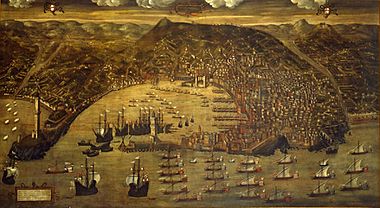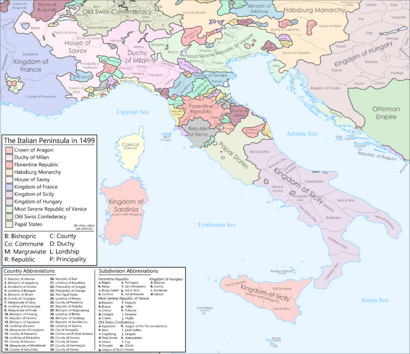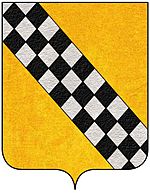Republic of Genoa facts for kids
Quick facts for kids
Republic of Genoa
|
|||||||||||||||
|---|---|---|---|---|---|---|---|---|---|---|---|---|---|---|---|
|
|||||||||||||||
|
Motto: Respublica superiorem non recognoscens
(Error: {{language with name/for}}: missing language tag or language name (help)) |
|||||||||||||||
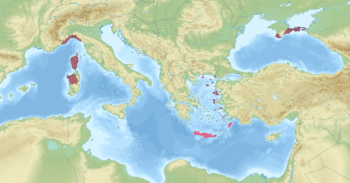
The Republic of Genoa in the early modern period
|
|||||||||||||||
| Capital | Genoa | ||||||||||||||
| Common languages | Ligurian Italian Latin Corsican Greek Arabic |
||||||||||||||
| Religion | Roman Catholicism | ||||||||||||||
| Government | Oligarchic merchant republic | ||||||||||||||
| Doge | |||||||||||||||
|
• 1339–1345
|
Simone Boccanegra (first) | ||||||||||||||
|
• 1795–1797
|
Giacomo Maria Brignole (last) | ||||||||||||||
| Capitano del popolo | |||||||||||||||
|
• 1257–1262
|
Guglielmo Boccanegra (first) | ||||||||||||||
|
• 1335–1339
|
Galeotto Spinola (last) | ||||||||||||||
| Podestà | |||||||||||||||
|
• 1191–1191
|
Manegoldo del Tettuccio (first) | ||||||||||||||
|
• 1256–1256
|
Filippo della Torre (last) | ||||||||||||||
| Legislature | Consiglio della Repubblica | ||||||||||||||
| Great Council | |||||||||||||||
| Minor Council | |||||||||||||||
| Historical era | |||||||||||||||
|
• Established
|
11th century | ||||||||||||||
|
• Participation in the First Crusade
|
1096–1099 | ||||||||||||||
|
• Treaty of Nymphaeum
|
1261 | ||||||||||||||
|
• Establishment of the Gazaria
|
1266 | ||||||||||||||
|
• Battle of Meloria
|
1284 | ||||||||||||||
|
• Creation of the Dogate
|
1339 | ||||||||||||||
|
• Foundation of the Bank of Saint George
|
1407 | ||||||||||||||
|
• Andrea Doria's new constitution
|
1528 | ||||||||||||||
|
• Disestablished
|
June 14, 1797 | ||||||||||||||
|
• Republic's revival
|
1814 | ||||||||||||||
|
• Disestablished
|
1815 | ||||||||||||||
| Population | |||||||||||||||
|
• Estimate
|
650,000 in the early 17th century | ||||||||||||||
| Currency | Genoese lira (1138–1797) Genovino (1252–1415) |
||||||||||||||
|
|||||||||||||||
| Today part of | Italy France Greece Tunisia Lebanon Turkey Ukraine Romania Russia Monaco |
||||||||||||||
The Republic of Genoa was a powerful trading nation that existed from the 11th century to 1797. It was located in Liguria, a region on the northwestern Italian coast. During the Middle Ages, Genoa was a major trading hub in the Mediterranean and Black Sea. Later, in the 16th and 17th centuries, it became one of Europe's most important financial centers.
Over its long history, the Republic of Genoa created many colonies across the Mediterranean and Black Sea. These included Corsica (from 1347 to 1768), Monaco, and parts of Crimea (from 1266 to 1475). It also controlled islands like Lesbos and Chios. As time went on, Genoa lost many of its colonies. It then focused more on banking, which helped it stay a key center for trade and finance.
Genoa was known by many nicknames, like "la Superba" (the Superb one) and "la Dominante dei mari" (the Dominant of the Seas). From 1339 until 1797, the leader of the republic was called the Doge. At first, the Doge was chosen for life. After 1528, they were elected for two-year terms. However, the Republic was actually an oligarchy, meaning it was ruled by a small group of powerful merchant families. These families were the ones who chose the Doges.
Genoa was famous as a "maritime republic," meaning a powerful trading city with a strong navy. Its coat of arms is even on the flag of the Italian Navy today. In 1284, Genoa won a big battle against the Republic of Pisa called the Battle of Meloria. This victory gave Genoa control over the Tyrrhenian Sea. Genoa was also a constant rival of Venice for control of trade in the Mediterranean Sea.
The Republic of Genoa began in the 11th century when the city of Genoa became a self-governing city-state. It ended in 1797 when Napoleon's French First Republic conquered it. Genoa was then replaced by the Ligurian Republic. This new republic was later taken over by France in 1805. After Napoleon's defeat, Genoa briefly became independent again in 1814. But in 1815, it was finally taken over by the Kingdom of Sardinia.
Contents
Genoa's Famous Names
The Republic of Genoa was officially known as Repubblica di Genova in Italian. The famous poet Petrarch called it La Superba (The Superb one). This name showed how glorious Genoa was and how impressive its buildings were.
For over 800 years, the republic was also known as la Dominante (The Dominant one). People also called it la Dominante dei mari (the Dominant of the Seas) and la Repubblica dei magnifici (the Republic of the Magnificents). These names highlight Genoa's power and wealth.
History of Genoa
Early Beginnings
After the Western Roman Empire fell, the city of Genoa was invaded by Germanic tribes. Around 643, the Lombard Kingdom took control of Genoa. In 773, the Frankish Empire took over the Lombard Kingdom. During these times, Genoa was a small town. It slowly built up its merchant fleet, which became very important for trade in the Western Mediterranean.
In 934–935, a Fatimid fleet attacked and burned Genoa. This event made people wonder if Genoa was just a small fishing village or a busy trading town at that time. In 958, a special document gave Genoa full legal freedom. This document also guaranteed that the city owned its lands.
By the end of the 11th century, Genoa adopted its own constitution. This new city-state was called a Compagna Communis. This local organization remained important for centuries.
Genoa Becomes Powerful
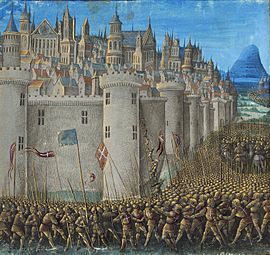
Before 1100, Genoa became an independent city-state. It was one of many such states in Italy. The Holy Roman Emperor was technically in charge, and the Bishop of Genoa was the city's president. But the real power was held by "consuls" chosen each year by the people.
Around this time, Muslim raiders were attacking coastal cities. In 1016, Genoa and Pisa worked together to defend Sardinia. In 1066, a war started between Genoa and Pisa, possibly over who would control Sardinia.
Genoa was one of the "Maritime Republics." These were powerful trading cities with strong navies. Other famous ones included Venice and Pisa.
In 1087, Genoese and Pisan fleets attacked Mahdia, a city in North Africa. This attack was supported by Pope Victor III. The attackers captured the city but could not hold it. They burned the Arab fleet in the harbor. This act gave Genoa, Venice, and Pisa control of the Western Mediterranean Sea. This control was very important for supplying the First Crusade (1096–1099) by sea.
Genoa began to grow even more during the First Crusade. In 1097, about 1,200 soldiers and 12 ships from Genoa joined the crusade. The Genoese fleet helped the crusaders by providing naval support. They were especially helpful during the siege of Antioch in 1098. Genoese soldiers also helped in the siege of Jerusalem in 1099.
After Antioch was captured in 1098, Genoa made an alliance with Bohemond of Taranto. He was the ruler of the Principality of Antioch. As a reward, Genoa received a headquarters and houses in Antioch. They also received relics of Saint John the Baptist for their help in the crusade. Many other places in the Middle East were given to Genoa, along with good trading deals.
Genoa also allied with King Baldwin I of Jerusalem. This alliance gave Genoa a share of land and income from cities like Arsuf, Caesarea, and Acre. Genoa's role as a sea power helped its merchants get many good trading agreements. They controlled much of the trade in the Byzantine Empire, Tripoli (Libya), and Egypt.
In 1147, Genoa helped Alfonso VII of León and Castile take back the city of Almería from the Muslims. Genoa received one-third of the city. This shows how Genoa expanded its power by letting private citizens manage overseas territories. In 1148, Genoa also helped capture Tortosa, getting another one-third share.
During the 11th and 12th centuries, Genoa became the strongest naval power in the Western Mediterranean. Its rivals, Pisa and Amalfi, became less important. Genoa and Venice also became central to the slave trade at this time. Genoa's main rival in the Mediterranean was Venice.
13th and 14th Centuries
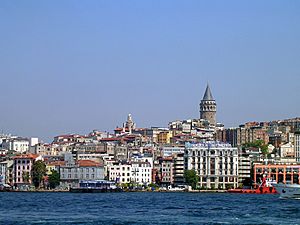
Genoa and Venice were big rivals in trade and culture throughout the 13th century. Venice played a key role in the Fourth Crusade. This crusade harmed Constantinople, which was a rival trading city. Venice then supported the new Latin Empire, which gave Venice strong trading rights in the eastern Mediterranean.
To get back control of trade, Genoa allied with Michael VIII Palaiologos. He was the emperor of Nicaea and wanted to take back Constantinople. In March 1261, they signed a treaty. On July 25, 1261, Nicaean troops recaptured Constantinople.
This event shifted power to Genoa. Genoa gained free trade rights in the Nicene Empire. Genoese merchants also received ports and trading posts on many islands in the Aegean Sea, like Chios and Lesbos. The city of Smyrna also became a Genoese trading post.
Genoa and Pisa became the only states allowed to trade in the Black Sea. Genoa also conquered many areas in Crimea, where it set up the colony of Caffa. The alliance with the Byzantine Empire made Genoa even richer and more powerful.
In 1282, Pisa tried to take control of trade in Corsica. In August 1282, part of the Genoese fleet blocked Pisan trade near the Arno river. Both Genoa and Pisa prepared for war in 1283. Genoa built 120 galleys and hired over 15,000 soldiers.
On August 5, 1284, Genoa's fleet defeated Pisa's fleet in the naval Battle of Meloria. Genoa captured 30 Pisan ships and sank seven. About 8,000 Pisans were killed. This defeat meant Pisa never fully recovered as a sea power. Genoa gained control of trade in Corsica. The Sardinian town of Sassari also came under Genoese control.

Genoese merchants also moved south to Sicily and North Africa. They set up trading posts to get gold from the Sahara Desert. In 1283, the people of the Kingdom of Sicily revolted against their rulers. This revolt was called the Sicilian Vespers. As a result, the Aragonese took control. Genoa had supported the Aragonese and was given free trading rights in Sicily. Genoese bankers also made money by lending to Sicily's new nobles. Corsica officially became part of Genoa in 1347.
Genoa was not just a place for spices. It was also a major center for weaving silk textiles. They imported silk thread and created beautiful fabrics.
However, Genoa began to decline in the late 14th century. This was partly due to economic problems in Europe. It was also due to its long war with Venice. This war ended with Genoa's defeat at Chioggia in 1380. This loss greatly weakened Genoa's navy and pushed it out of eastern Mediterranean markets. The rising Ottoman Empire also took over many Genoese trading posts.
In 1396, to protect itself from internal problems, Genoa's Doge Antoniotto Adorno asked Charles VI of France to be the "defender of the municipality." This was the first time Genoa was controlled by a foreign power.
The Golden Age of Genoese Bankers
The 15th century was a difficult time for Genoa. The city was known for trading goods from the Middle East and for its financial skills. After a short period of French rule (1394–1409), Genoa came under the control of the Visconti of Milan. Genoa lost Sardinia to Aragon and Corsica to a rebellion. It also lost its colonies in the Middle East and Black Sea to the Ottoman Empire.
Despite these losses, two of the world's earliest banks were founded in Genoa in the 15th century. The Bank of Saint George, founded in 1407, was the oldest state bank. The Banca Carige, founded in 1483, still exists today.
Christopher Columbus was born in Genoa around 1451. He gave a part of his earnings from his discoveries in the Americas to the Bank of Saint George. This money was used to help reduce food taxes.
In 1458, the Doge of Genoa gave control of the Republic to the French. It became the Duchy of Genoa under a French governor. But Genoa revolted with help from Milan, and the Republic was restored in 1461. Milan then changed sides and conquered Genoa in 1464. From 1499 to 1528, Genoa was almost always under French control.
On May 30, 1522, the Spanish captured Genoa and looted the city. But in 1528, the great admiral Andrea Doria allied with Emperor Charles V. They drove out the French and brought back Genoa's independence. This year also marked the first loan from Genoese banks to Charles V.
During this time of economic recovery, many rich Genoese families became very wealthy. These families included the Balbi, Doria, Grimaldi, and Pallavicini. Some historians believe that Genoa's trading practices in the Mediterranean were important for the exploration of the New World.
In the 16th century, Genoa attracted many famous artists. These included Rubens, Caravaggio, and Van Dyck. Architects like Galeazzo Alessi designed many beautiful palaces in the city.
Genoa then had a revival as a partner of the Spanish Empire. Genoese bankers helped finance many of Spain's foreign projects. Historian Fernand Braudel called the period from 1557 to 1627 the "age of the Genoese." This was because Genoese bankers provided money to the Spanish crown. In return, silver from America was sent to Genoa to fund more projects.
From about 1520, the Genoese controlled the port of Panama. This was the first port on the Pacific founded by the Spanish in the Americas. Genoa used this port mainly for the slave trade until the city was destroyed in 1671.
However, Spain's decline in the 17th century also led to Genoa's decline. Spain's frequent bankruptcies ruined many Genoese merchant families. In 1684, a French fleet heavily attacked Genoa. This was punishment for Genoa's alliance with Spain.
Genoa's Decline
In May 1625, a French-Savoian army briefly attacked Genoa. The Spanish helped lift the siege. But in May 1684, the French again attacked the city. Between these attacks, a terrible plague killed about half of Genoa's people in 1656–1657.
Genoa continued to decline in the 18th century. It lost its last Mediterranean colony, the island fortress of Tabarka, to the Bey of Tunis in 1742.
In 1729, Genoa faced another rebellion in Corsica. This was a major break between the island and Genoa. The Genoese government asked Charles VI for help. He sent 10,000 German soldiers. Genoa managed to stop the rebellion for a while. But another revolt broke out in 1733. Genoa tried to ban private guns in Corsica, but it didn't work. A long war continued until Genoa sold Corsica to France in 1768.
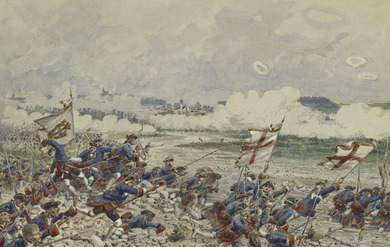
In 1742, Austria allied with the Kingdom of Sardinia. This worried Genoa. In 1743, Genoa decided to join the House of Bourbon in the War of the Austrian Succession. Genoa signed a secret treaty with France, Spain, and Naples. On June 26, 1745, Genoa declared war on the Kingdom of Sardinia.
This decision was bad for Genoa. It surrendered to the Austrians in September 1746. The city was briefly occupied before a revolt freed it two months later. The Austrians returned in 1747 and attacked Genoa again. But a Franco-Spanish army drove them away.
Genoa kept its lands in the Peace of Aix-la-Chapelle. But it could not hold onto Corsica. After driving out the Genoese, the Corsican Republic was declared in 1755. Genoa had to rely on French help to stop the rebellion. In 1768, Genoa was forced to give Corsica to the French in the Treaty of Versailles.
The End of the Republic
By 1794 and 1795, ideas from the French Revolution reached Genoa. In May 1797, Genoese revolutionaries and French citizens tried to overthrow the government. This led to fighting in the streets.
Napoleon directly intervened. His actions led to the fall of the Republic in early June 1797. The old ruling families were overthrown. On June 14, 1797, the Ligurian Republic was created under French control. After Napoleon took power in France, the Ligurian Republic was annexed by France in 1805. It became French departments.
When Napoleon fell, Genoa briefly regained its independence in 1814. It was called the Repubblica genovese. But this lasted less than a year. The Congress of Vienna decided that Genoa and all of Liguria would become part of the Kingdom of Sardinia. This went against the idea of bringing back old governments.
How Genoa Was Governed
The history of Genoa's government is divided into five main periods:
- Consuls: 11th century–1191
- Podestà: 1191–1256
- Capitano del popolo: 1257–1339
- Doge (elected for life): 1339–1528
- Doge (elected for two-year terms): 1528–1797
The republic was mostly democratic at first. Later, the Podestàs and Captains of the people tried to balance authority and freedom. The Doges often claimed to be for the common people, even though they sometimes acted like an oligarchy. The last period of the republic was ruled by aristocrats. By tradition, church leaders in Genoa could not hold public office.
Important Families
In the first two centuries of the Doge system, the Adorno and Fregoso families often fought for the position of Doge.
After the changes in 1528, many of the 79 Doges elected for two-year terms came from a small number of noble families. These families were organized into 28 "Alberghi" (family groups). Some of the most powerful families included:
- Grimaldi: 11 Doges
- Spinola: 11 Doges
- Durazzo: 8 Doges
- De Franchi, Giustiniani, and Lomellini families: 7 Doges each
- Centurione: 6 Doges
- Doria: 6 Doges
- Cattaneo: 5 Doges
- Gentile: 5 Doges
- Brignole: 4 Doges
- Imperiali: 4 Doges
- De Mari, Invrea, and Negrone families: 4 Doges each
- Pallavicini: 3 Doges
- Sauli: 3 Doges
Other important families of the Republic of Genoa were:
- Fieschi: They were counts of Lavagna and two Popes came from this family.
- Gattilusi: They ruled many lands in the Aegean Sea, like Lemnos and Lesbos.
- Embriaco: They were lords of Gibelet for almost 200 years. They were also important in the history of the Crusader states.
Genoa's Territories
When it was founded in the early 11th century, the Republic of Genoa included the city of Genoa and its surrounding areas. As the city's commerce grew, so did its territory. By 1015, all of Liguria was under Genoa's control.
After the First Crusade in 1098, Genoa gained settlements in Syria. However, it lost most of them during Saladin's campaigns in the 12th century. In 1261, the city of Smyrna in Asia Minor became Genoese territory.
In 1255, Genoa started the colony of Caffa in Crimea. Later, Genoa established more colonies in Crimea, such as Soldaia and Cherco. In 1275, the Byzantine Empire gave the islands of Chios and Samos to Genoa.
Between 1316 and 1332, Genoa set up colonies in the Black Sea, including La Tana and Samsun. In 1355, the Byzantine Emperor John V Palaiologos gave Lesbos to a Genoese lord. By the end of the 14th century, Genoa also controlled a quarter of Constantinople and Trebizond. However, the Ottoman Empire conquered most of Genoa's overseas territories during the 15th century.
Other Lands Outside Italy
- Giudicato of Logudoro (part of Sardinia) from 1259–1325
- North Aegean Sea possessions, centered at Chios from 1261–1566
- Southern Crimea possessions of Gazaria from 1266–1475 (lost to the Ottoman Empire)
- Island of Corsica from 1284–1768
- The cities of Gibelet and Tyre (in present-day Lebanon)
- City of Tabarka in northwest Tunisia from 1540–1742
- The cities of Calafat, Giurgiu, and Galați (in present-day Romania) around the 14th century
Genoa's Economy
Genoese traders bought salt from various places like Sardinia, Spain, and the Black Sea. They used this salt to make salami. They then sold salami in southern Italy for raw silk. This silk was sold in Lucca for fabrics, which were then sold to Lyon.
Mule caravans carried salt directly from Genoa to Piacenza. From there, it was put on river barges and sent down the Po river to cities like Parma and Bologna. Along these trade routes, Genoa competed with Venice for salt and other goods like salami, ham, cheese, textiles, and spices.
See also
 In Spanish: República de Génova para niños
In Spanish: República de Génova para niños




